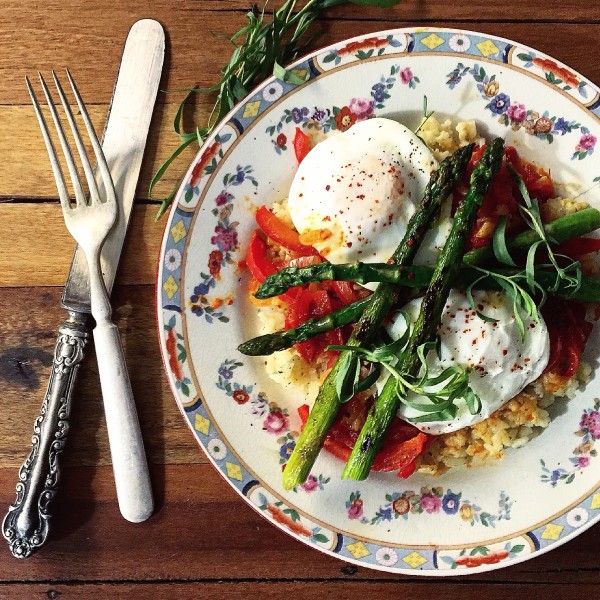This is the first time I am actually letting you know about a recipe I’ve tried for the Instagram cookbook club I belong to.
 Every month Deborah Balint of @rainydaybitescookbookclub curates a unique book for us to explore. There is no pressure, we can choose, cook and post as we please. But it is a great way to explore a cookbook fully. How often do we purchase a cookbook because the photos were gorgeous, the author was compelling, or there were a few must make recipes? And then it quickly fades from our consciousness and sits on the shelf. Being part of a cookbook club, we really concentrate on a cookbook for a whole month; and with the contributions of photos by others of recipes we may have overlooked, we are suddenly intrigued by those very recipes. Win win.
Every month Deborah Balint of @rainydaybitescookbookclub curates a unique book for us to explore. There is no pressure, we can choose, cook and post as we please. But it is a great way to explore a cookbook fully. How often do we purchase a cookbook because the photos were gorgeous, the author was compelling, or there were a few must make recipes? And then it quickly fades from our consciousness and sits on the shelf. Being part of a cookbook club, we really concentrate on a cookbook for a whole month; and with the contributions of photos by others of recipes we may have overlooked, we are suddenly intrigued by those very recipes. Win win.
This month we are using ‘The Broad Fork: Recipes for the Wide World of Vegetables and Fruits’ by Hugh Acheson. So last night, I made this recipe. First of all, I knew I liked all the ingredients, there wasn’t anything really new or unusual. But this is truly a dish where the whole is greater than the sum of the parts. Grilled asparagus, poached eggs- love them both. Grits- I love them, Jim is ambivalent. So I replaced them with risotto. Still creamy, so a pretty good replacement. But the piperade! A brand new dish for me. It is a classic Basque (Spanish) tomato/pepper relish, that is divinely spicy and rich. This must become part of your arsenal. After this meal, I can see using it on burgers, in frittatas, on top of pizza, in pasta, even in a crusty roll with grilled sausage. And it is for this piperade that I am sharing this brilliant recipe. A few steps, but easy to execute. The piperade can be made in advance by even a day or two. The grits or risotto can be made and kept warm. Same goes for the asparagus.
If you wanted to make this for breakfast or brunch, just make up your rice the night before and keep in the fridge. Or make grits the morning of, and you’re all set.
And the poached eggs, well, I’m finally letting you in on my secret. Paola from the ‘Cravings in Amsterdam‘ has already given me a great shout out for my secret, and for this I am truly appreciative. But I can’t take credit for it. I’ve been doing poached eggs for about 2 years this way. Don’t ask me where I learned the trick. I wish I could remember. The secret is this: a small sieve. Yes, a sieve. Cracking the egg into the sieve over a bowl allows the loose bits of egg white to fall away. Hold it in here for about 20-30 seconds before taking the sieve and tilting it into only the gently simmering water and releasing the egg. You will find that there is no loose white that gets caught away from the egg, and that it poaches all intact. Works every time 🙂
And if you really didn’t want to go through the process of poaching the eggs, a great sunny side up egg would work equally well. It’s almost breakfast for dinner. Who doesn’t love that!?
Love Jen


GRIDDLED ASPARAGUS, PIPERADE, POACHED EGGS AND GRITS
Ingredients
- 2 cups chicken stock
- 2 tablespoons unsalted butter
- Sea salt
- 1/2 cup white corn grits
- 1/2 cup heavy cream
- 3 tablespoons olive oil
- 4 garlic cloves , thinly sliced
- 1/2 cup thinly sliced shallots
- 1 cup julienned red bell pepper
- 2 roma tomatoes , peeled and coarsely chopped
- 2 bay leaves
- 1 teaspoon ground Espelette pepper (I didn't have this in the pantry, so replaced this with Aleppo pepper)
- 1 tablespoon sherry vinegar
- 1/2 pound asparagus , tough ends removed, spears peeled if thick
- 4 Perfectly Poached Eggs
Instructions
-
In a medium saucepan, combine the chicken stock, butter, and sea salt to taste, and bring to a boil over high heat. Whisk in the grits and stir for 1 minute with a wooden spoon. Reduce the heat to low and cook the grits, stirring often, for 20 minutes or until they are tender.
-
Finish the grits with the cream, add more sea salt to taste, and stir well.
-
Cover to keep warm. (I use the waxed paper from a stick of butter for this, placed butter side down over the grits so they don't develop an unseemly crust.)
-
Meanwhile, in a medium saucepan combine 2 tablespoons of the olive oil and the garlic. Slowly cook the garlic over medium-low heat, making sure not to allow any color to develop, for about 5 minutes. Add the shallots, bell peppers, and a few pinches of sea salt. Cook for 12 minutes or until tender.
-
Add the tomatoes, bay leaves, and Espelette pepper. Continue to cook for 15 more minutes or until the consistency is much like a thick soup. Finish with the sherry vinegar and sea salt to taste, and cover and set aside to keep warm. Remove the bay leaves prior to serving.
-
Place a large cast-iron sauté pan over medium-high heat. In a mixing bowl, toss the asparagus, the remaining tablespoon of olive oil, and a few pinches of sea salt. When the pan is giving off a light smoke, place the asparagus in the hot pan and cook for 2 minutes. Turn the asparagus over and cook for an additional 2 minutes. The asparagus should have good, even char marks all around and be crisp-tender. Remove from the heat.
-
Spoon the grits evenly onto 4 plates. Place a poached egg on each plate, and arrange the griddled asparagus and pipérade over the top.
JENNIFER'S POACHED EGGS
-
Room temperature eggs
-
Use a large pot that is at least 8 inches in diameter and holds 8 cups of water or more.
-
Many swear by the swirl technique. Sometimes it works for me, sometimes it doesn't. But a rapid simmer is a must. If you do get the water swirling first, make sure to tip the egg into the centre or vortex of the water.
-
1 tbsp of vinegar helps hold the egg together. But not absolutely necessary.
-
Use a good perforated spoon to extract the eggs from the water.
METHOD
-
Bring 6-8 cups of water and the vinegar to a boil. Add 1 tbsp of sea salt.
-
Reduce the heat so that the water is now at a rapid simmer. The tiniest of bubbles.
-
While the water temp is reducing crack each egg into the small sieve held over a bowl. Let the excess egg white drip out for about 20 seconds. Transfer the sieve to the water, tilt and let the egg fall into the just short of bubbling simmering water.
-
I go 2.5-3 minutes for a soft yolk. The time is affected by the temp and the size of the egg. You'll be able to tell, by using the whites as a gauge. If they are set and opaque, and you like a runny yolk, you're done! Obviously if you want a firmer yolk, simmer longer. Scoop out the egg with the slotted spoon and transfer to a paper towel lined plate.
-
With the above recipe, since you are cooking 4 eggs, you may want to prepare the eggs ahead, by draining one by one in the sieve and transferring to a small bowl or teacup. Then when it is time to cook, you can transfer each egg into the water at the same time.
Recipe Notes
The grits call for white corn grits or ground hominy corn. If you can't find this, using the ground yellow corn for polenta will work fine as well. But then of course, it is polenta and not grits. But hey, any port in a storm.
I made a cheater risotto by taking arborio rice and adding it to the chicken stock, butter and salt in my rice cooker (follow your rice cooker's directions for the amount you want) It produced a perfectly creamy risotto base for the meal. I added more that the asked for pepper. But then again, we like our heat! I leave it up to you to season accordingly. A little cracked pepper was also added, just because I wanted it.
This piperade is so versatile. Let me know what other ways you come up with to use it!
By Hugh Acheson Adapted from The Broad Fork: Recipes for the Wide World of Vegetables and Fruits

Looks so delicious!
Oh thank you so much Poala! Your recipes and photos are such an inspiration.
This looks so so delicious. Love poached eggs and yes, the sieve is such a great idea.
xx
Oh thanks so much Asha! Before I started using the sieve method, I was so discouraged with my poached egg results. For some reason it really works for me. I appreciate your comments and inspiration 🙂